Why Crystals and Minerals are important for HUMAN development
Compositions and Descriptions
I’m covering this information in this posts, because it is one out of many solutions to the targeting that Targeted Individuals are experiencing. However, the post is for information and should not be taken as scientific fact. Please use your own judgement.
Readers advised. Government Sponsored Stalking does not endorse the content below. Please use your own judgement.
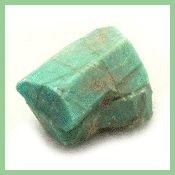 |
Amazonite is a beautiful green variety of microcline feldspar. Its chemical formula is KAlSi3O8 , potassium aluminum silicate. |
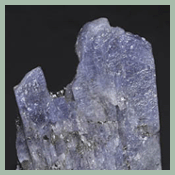 |
Tanzanite is a variety of Zoisite. It is valued as a gem stone and has the chemical formula Ca2Al3Si3O12(OH). |
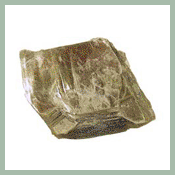 |
The Mica Group is the name given to a group of silicate minerals that have silicon and oxygen as their two major components. |
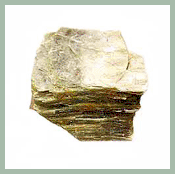 |
Muscovite is a member of the mica mineral group. It is more important as a rock-forming mineral than as a collectible specimen. |
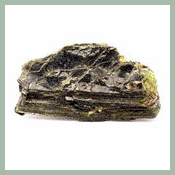 |
Biotite Biotite is a member of the mica branch of the silicate mineral group. It is common as a rock-forming mineral and is present in all three rock types: igneous, metamorphic, and sedimentary. |
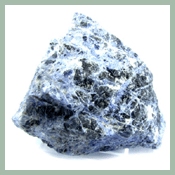 |
Sodalite is a deep royal blue silicate. The deep color and the fact that it will take a high polish makes it popular in jewelry and other decorative items. The chemical formula is Na8Al6Si6O24Cl2. |
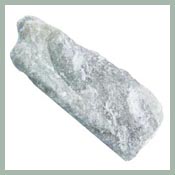 |
Talc is a metamorphic mineral from the silicate family. Its chemical formula is hydrated magnesium silicate H2Mg3(SiO3)4. Talc is commonly used as talcum powder to reduce friction, promote dry skin, and prevent rashes. |
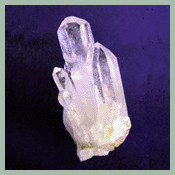 |
Quartz is one of the most common of all minerals that make up the continental crust. It is found in igneous, metamorphic, and sedimentary rocks. It is associated with many valuable ore deposits as well. |
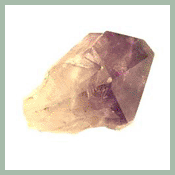 |
Amethyst is a variety of quartz and owes its purple color to the presence of iron. It is composed of silicone dioxide SiO2. |
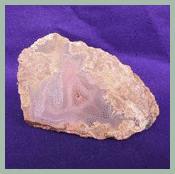 |
Agate is the name given to a group of silicates that are made up primarily of chalcedony. Chalcedony is a member of the quartz family of minerals. Like quartz chalcedony is silicone dioxide with a chemical formula of SiO2. |
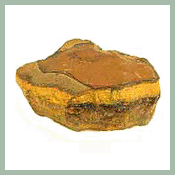 |
Tigers Eye is a form of quartz with some special characteristics. Like all quartz it is made up primarily of silicone dioxide, SiO2. Within this matrix are asbestos fibers usually occurring in layers. It is the asbestos that makes Tiger eye a chatoyant gemstone. |
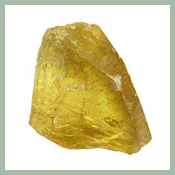 |
barite is a sulfate mineral with a chemical formula of BaSO4, sometimes called heavy spar. Its chemical name is barium sulfate. It is the primary source of the element barium. |
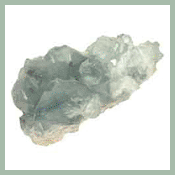 |
Celestite is made up of strontium sulfate. The chemical formula is SrSO4. Its name comes from Latin, caelestis meaning celestial. |
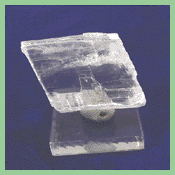 |
selenite Selenite is a very common chemical sedimentary mineral. Its chemical formula is Calcium Sulfate dihydrate CaSO42H20, It is a form of gypsum. It is a very soft mineral. |
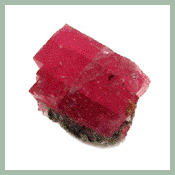 |
Rhodochrosite is a manganese carbonate mineral. Its chemical composition is MnCO3. In its purest form it is a transparent rose red, but this is fairly rare. It can also be formed in stalactites. This form can be sliced revealing circular layers of rose and pink to milky white. These lighter colors are formed when the manganese is replaced by calcium, manganese or zinc. The depth of color from red to pink depends on the amount of substitution. |
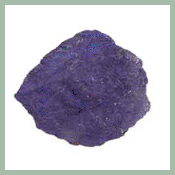 |
Azurite is a copper carbonate. The chemical formula is Cu3[OH CO3]2and results from the oxidation of copper sulfides. |
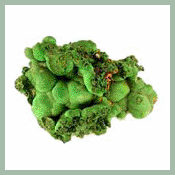 |
Malachite is a copper carbonate with a chemical formula of Cu2[(OH)2 CO3]. It is a vibrant green color often banded with light and dark greens. |
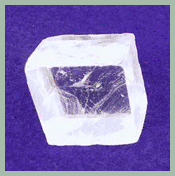 |
Calcite Calcite is a very common sedimentary mineral. It has the chemical formula CaCO3 calcium carbonate. Calcite dissolves in water and so is carried along with water into cracks, fissures, and caves. It can over time build up layer upon layer to form stalactites and stalagmites in caves. |
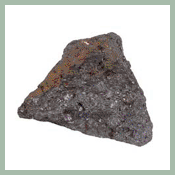 |
Magnetite is sometimes called lodestone. It is strongly magnetic. It was used by the ancient Chinese to make the first magnetic compasses. The chemical formula is Fe3O4. |
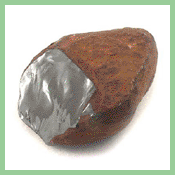 |
Hematite is one of the most prevalent and useful forms of iron on our planet. It is a common iron ore and is often used in jewelry and other decorative items. The chemical formula is Fe2O3. |
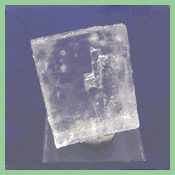 |
Halite Halite is also known as rock salt. The chemical name is sodium chloride NaCl It is called an evaporate. It forms in places where sea water has been isolated from the ocean forming a lake. |
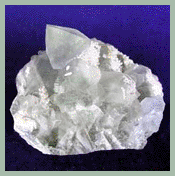 |
Fluorite Fluorite is a halide that is soft and usually colorless but can be blue, purple, green, brown, or yellow. Some times several colors are present in the same crystal creating a striking affect. |
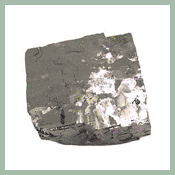 |
Galena has been mined for lead and silver since the time of the Romans. It is a form of lead sulfide. The chemical formula is PbS. It is the most important source of lead and is abundant and widespread in occurance. |
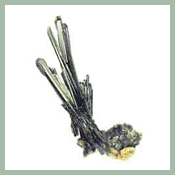 |
Stibnite Stibnite is a sulfide found in low temperature hydrothermal veins and hot springs deposits. It is prized by collectors for the long slender bladed crystals. These can occur in clumps with many orthorhombic crystals radiating in all directions. It is very soft only a 2 on the Mohs hardness scale. |
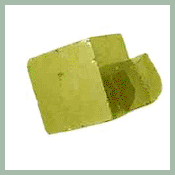 |
Pyrite sometimes called iron pyrite is a compound of iron and sulfur, iron sulfide FeS2. Depending upon the conditions under which it forms pyrite can form crystals of different shapes. |
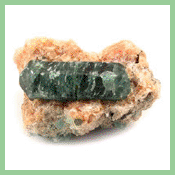 |
Apatite is the name given to a group of phosphate minerals that are widely distributed in all rock types, usually in tiny crystals spread throughout the host rock. It is usually green in color. |
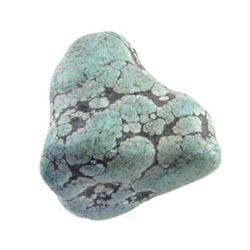 |
Turquoise is classed as a phosphate mineral. The chemical formula is CuAl6(PO4)4(OH)8 4H2O a hydrous phosphate of copper and Aluminum. |
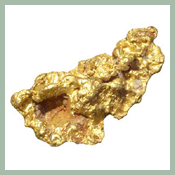 |
Gold is a soft metallic element. Its symbol is Au. It is very dense. As one of the noble metals it is resistant to corrosion and oxidation in moist air. |
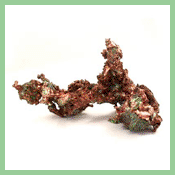 |
Copper is a soft metallic element. Its symbol is Cu. Native copper is rare because it has been mined for centuries. Today it is used for making wire, tubing, and coins to name a few. Long ago it was combined with tin to create bronze. |
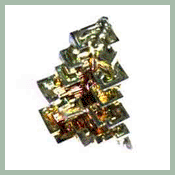 |
Bismuth Crystals Bismuth in its elemental form is a rare occurance in nature, even more so for bismuth crystals. Lab grown crystals are popular because of their intricate shapes and dazzaling colors. |
| Silicon Silicon is a metallic element used to make computer chips and other electronic equipment. Although it is the second most abundant element in the world it was not discovered until 1824. | |
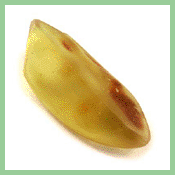 |
Mineraloid is the term used for those substances that do not fit neatly into one of these eight classes. Opal, jet, amber, and mother of pearl all belong to the mineraloids. |
further definitions can be found here: http://www.bestcrystals.com/crystals2.html
